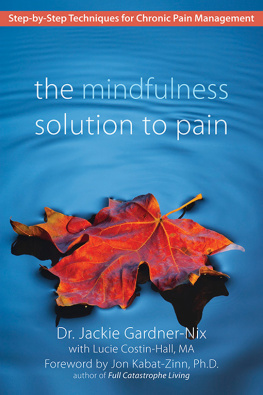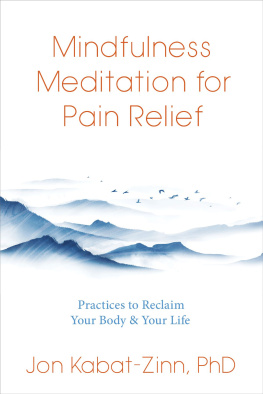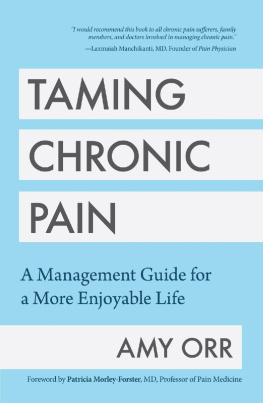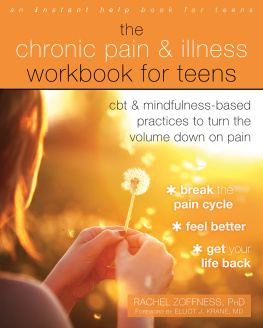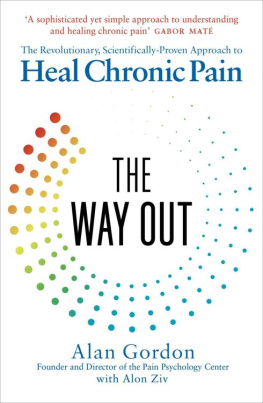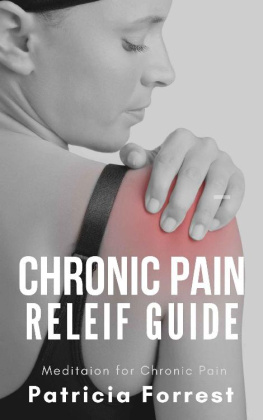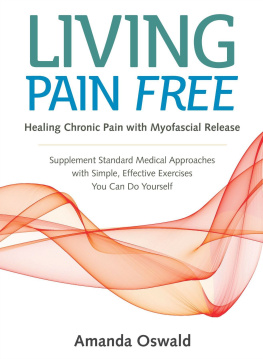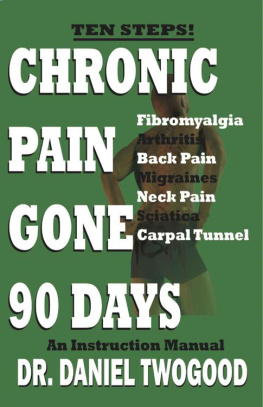Chapter 1
getting started on managing your pain: understanding why you have it
Meditation is not to escape from society, but to come back to ourselves and see what is going on. Once there is seeing, there must be acting. With mindfulness, we know what to do and what not to do to help.
Thich Nhat Hanh
You might ask: Why have I been in pain for years, and someone with a similar story was completely healed? Why can someone have a terrible accident, fractured pelvis, fractured limbs, ruptured spleen, the whole enchiladaand end up a few months later with no pain? But my pain, even from a lesser injury or a milder chronic illness, stayed on and on and on? Is it really something to do with how my mind affects my ability to heal and function, or not function, with pain?
We know that the way you handle challenging life eventsand reading this book and doing the work in it is a challenging eventalso depends on the examples you were set by your parents or whomever reared you. As a deeply impressionable child, you watched and often subconsciously copied for the rest of your life, the behaviors that were modeled for you. If your parents were quitters, youre more likely to be a quitter too. Or you might have noted that they were quitters and already changed that mind-set for yourself.
the mind-body connection
You may have forgotten any knowledge of biology and chemistry that you ever studied a long time ago, so well try to make this simple. The human body, like all living organisms, is made up of chemicals. This may be a hard fact to absorb when nowadays so many people think of chemicals as synthetic and bad, and natural substances such as those we buy in the health food stores as good and safe. Physicians are always quelling their tendency to roll their eyes when they encounter that misconception. But to show you how drugs and meditation work we have to refer to chemistry.
The Chemistry of Thought
Hormones are chemicals (hence the sentence There was chemistry between them in steamy novels); enzymes are also chemicals; and the various elements we measure in blood tests are all chemicals that give us clues about how well various organs, such as the liver and kidneys, are functioning. Neurotransmitters are the chemicals in your nervous system, including your brain, that influence your moods, your emotions, your thought processes, and every function in your body.
When the chemicals are out of balance in your mind and body, you malfunction. That malfunction could lead to a tight or weak muscle, an acidic stomach, an abnormal heart rhythm, a poorly functioning liver or kidney, a depression, a panic attack or a migraine: it all depends on what the particular set of chemicals is and where the imbalance is located.
Interestingly, thought processes also work by changing the balance of chemicals, and so do drugs. Health care professionals try to restore your chemical imbalances to nearer normal balances with drugs. But in many situations and, probably, the earlier the better, you also can go a long way toward restoring normal chemical balances by changing your thought processes too. At first, this might not work as quickly as drugs do, although it probably is longer-lasting. Moreover, thought processes have fewer side effects.
Its intriguing that medication, as a word, is so similar to the word meditation. Perhaps the c is for chemical, and the t for thought. Which one would you rather use to get better, if you were given the choice and training?
Nature and Nurture
Why do the body and mind break down? Weve long realized that chance is seldom a major part of the reason for a breakdown. Through taking thousands of detailed patient histories, reading the research literature, and seeing the remarkable outcomes patients experience from our courses, we have come to believe that illness, both mental and physical, and healing after injury or surgery are affected by both genetics (nature) and the experiences to which youve been exposed in life (nurture).
However, it isnt the severity of the challenging life events you encounter that affects how much your body gets sick in the future, but how negatively and intensely you reacted to those events; and how your parents or caregivers reacted. By showing you when you were a child how they, the adults, managed stressful events, they were a major influence on how you cope as an adult. Managing stress, which may have been very challenging when you were a child (the most impressionable time of your life) without good parental nurturing, apparently changes how you manage stress as an adult, even at the level of genetic material. Chronic stress leads to a poorer functioning immune system, the system that is crucial for body repair.
In David Suzukis program, The Nature of ThingsPassion and Fury: Anger shown on Canadian television (CBC), he described a study in chimpanzees, which showed that the teenage ape deprived of maternal attention when young is alright when life is routine, but becomes very stressed in adverse situations, especially when compared to maternally well-nurtured teenaged counterparts. Both morphine and antidepressants help the maternally deprived apes to cope better when facing challenges in teen and adult life. It is likely that those studies contribute to the understanding of addictions. But they also suggest that the quality of the parenting received in childhood is crucial in causing adults to be more or less vulnerable to the body malfunctioning later in life.
For example, you may have the genes in your genetic material to develop rheumatoid arthritis; but those genes might never be expressed in your body if it were not for certain events in your life that activate them. And those events may be multiple. Psoriasis, a skin disease that runs in families, for example, is known to cause itchy rashes to break out at times of stress, which could include a combination of several mild stressors, such as an emotional upset combined with sleep deprivation, and poor eating habits. Jon Kabat-Zinn and colleagues (1998) demonstrated that psoriasis sufferers, who were meditating when they received healing light therapy, had an increased rate of healing of their rashes when compared to a control group of psoriasis sufferers who received healing light therapy alone without meditating.
If you cope well with stress because during your childhood your caregivers showed you how to cope by example and teaching, or because you were born with a temperament that tends toward stoicism, you may never encounter a disease for which you have a genetic predisposition. But if events were very stressful in your early life or your parenting was deficientand this isnt a blame gamethis is just describing how it works, your stress system goes on high alert easily and frequently; and you may be more likely to develop an illness or disease or not heal well after surgery or an injury.
Its also helpful to understand that if you had inadequate or poor nurturing from your caregivers, it is likely that they, too, were poorly parented. Inadequate nurturing skills are handed down generation after generation unfortunately, until someone breaks the cycle. But you cant fix what you cant see. Mindfulness helps us to see.
the biology of stress
Emotional distress causes stress hormones to fire up: you may have heard of the fight-or-flight reflex. When that reflex response to stress happens, several processes in your body that are not essential for your immediate survival slow down and go on hold. So, the processes of your gastrointestinal tract slow down (you may feel nauseous when upset), and your immune system also slows (you become more open to infection and you heal more slowly). But the body processes that can help you to survive are activated and go on high alert. For example, your heart beats faster because it is affected by the extra amount of adrenaline that is fired up to power your muscles (which tense up) to run from or fight the threat, and because you are on high alert, your sleep is disrupted.
Next page
